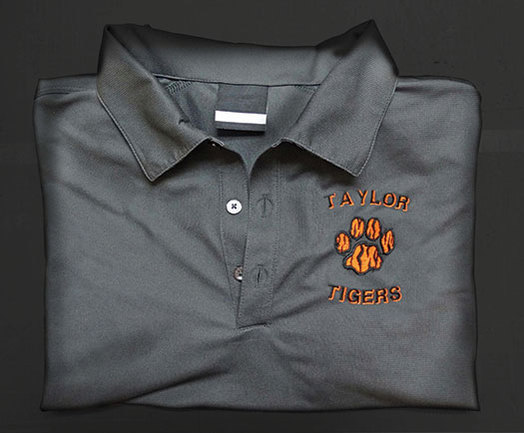Machine Embroidery Needles 101
Understanding the differences between machine embroidery needles and knowing which needle to use for each project will go a long way in developing your skills as a proficient commercial embroiderer.
FULL STORY
Performancewear isn’t a fad. In fact, the term “athleisure” — where work clothes meet workout attire — is seen on printed signs in retail stores, guiding buyers to the comfortable, drapey, clothing that has gained so much popularity recently.
The fabrics used in athleisure garments are designed for movement, comfort, stretch and moisture wicking, but not ostensibly for embroidery. But the right combination of thread, needle, stabilizer, etc., can help guarantee that you stay in the game.
Your customers will be pleased with the results, and their word-of-mouth advertising will keep new business coming through your door.
Pregaming
When it comes to embroidering designs on athleisure garments, you may have to educate your customers. Make them aware of the types of designs that can be embroidered on such challenging fabrics. For example, those with low density that won’t overly restrict fabric that was meant to “give” will be suitable. Avoiding high stitch counts is another way to skirt this issue.
Remember the push and pull of the fabrics used in athleisure garments. The stitches that are meant to embellish, brand or personalize them automatically will impede their functionality. So the lighter the density, the more movement the garment will allow. Look for designs with satin stitches and avoid those that require a lot of fill. Full-back or front designs also should be avoided.
On Your Mark
As with all embroidery projects, stabilizer choice will be a major factor in your finished design’s success. Stabilizer manufacturers have kept up with fashion trends, and there are several choices that will enhance your embroidery on athleisure garments. So many embroiderers come up with what works best for them through trial and error.
Choose a low-profile backing, such as E-Zee Weblon No Show or another brand, for designs that are 7,000 stitches or fewer. For designs with more than 7,000 stitches, you can use up to two pieces of low-profile stabilizer. Using a piece of the Weblon No Show, combined with a lightweight, 1-ounce tearaway stabilizer for the bottom layer, will add stability and a crisp look to the overall design.
Always remember a garment’s end use during hooping. Once a design is embroidered onto stretchy fabric, you are working against its purpose: ease of motion. So, when hooping, allow for a slight amount of stretch and remember points of impact. Adjust your hoop so that it barely holds the garment before stabilizer is added. Then, test the final hoop tension with the stabilizer, adjusting as needed.
In some cases, a light amount of spray adhesive can secure backing to the athleisure garment. This would be ideal when hoop burn needs to be avoided.
Get Set
In choosing the correct thread, needle and bobbin for embroidering on athleisure garments, your overall goal is to “relax the stitches.” In this case, rayon thread — which is softer, flexible and will lay nicely into a design — is your best choice. It also requires less tension.
Of course, if there is any chance the garment will be bleached — a rare occurence with quality performance garments — then polyester thread is ideal. However, polyester requires more tension, which may result in additional stress on the garment and puckering. Rayon thread will maintain the soft hand and its luster is more subtle than that of polyester.
Use the thinnest-possible ballpoint needle; a #65/9 or #70/10 can be used with 40-weight embroidery thread. The needle should create the thinnest point of penetration and the ball point will avoid snags or “runs.”
An alternative would be a universal point, which can perform like a ballpoint needle. Embroiderers like the former because it eliminates the need to stop and change needles. A 50-weight metallic thread can be used without a needle change. If you are about to begin an order, however, you may want to start with a quick needle change to avoid burrs that may have developed on needles over time.
A quality bobbin always should be used for best results. Before each new project, test and adjust bobbin tension, if necessary. Correct tensions should be between 20 and 25 grams on a Towa bobbin gauge. Stay on the lower side of the scale for athleisure garments.
Go…Embroider
Practice embroidering these garments ahead of the job by purchasing extra pieces and working out your “first-game” nerves.
The final step of embroidering should include lightly pressing the garment with a steam iron. This will relax the stitches and eliminate puckering.
With athleisure booming in popularity, you will — in all likelihood — be asked to embroider on these fragile fabrics. Following these tips will either keep you in the game — or ahead of it.
Alice Wolf is the marketing communications director for Madeira USA. She began doing marketing and public relations for the art industry in New York, then migrated north to Madeira’s New Hampshire headquarters. For more information or to comment on this article, email Alice at awolf@madeirausa.com.
Understanding the differences between machine embroidery needles and knowing which needle to use for each project will go a long way in developing your skills as a proficient commercial embroiderer.
FULL STORYWhether you’re running a small boutique embroidery shop or managing a large-scale decorated-apparel operation, attracting more customers to your business is crucial for growth and sustainability.
FULL STORYThere’s nothing more frustrating than being under pressure to get a job out and having something go wrong—and there are so many things that can go wrong!
FULL STORY